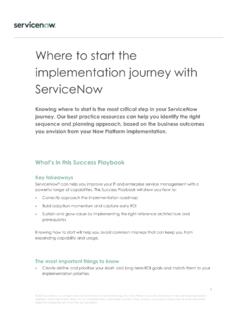Transcription of MARKETING COMMUNICATIONS PLAN - ANA Business …
1 Follow this simple step-by-step playbook to create a MARKETING COMMUNICATIONS plan that supports its MARKETING COMMUNICATIONS PLANP laybook & ToolkitTable of ContentsMARKETING COMMUNICATIONS PLANI ntroduction04 Conclusion24 Framework03 About This Playbook25 Strategy & Environment0608 Audience10 Objectives13 Messages16 Channels21 Budget & Measurementstagestagestagestagestagestag e123456 MARKETING Strategy ScorecardProductMarketing PlanKey MARKETING Metrics DashboardCustomer Profile TemplateBudget TemplateMessage Mapping ToolCampaign Impression CalculatorSocial Media Channel Selection ToolSocial Media Posting CalendarTradeshow Evaluation MatrixEvents Database TemplateMarCom CalendarMarketing Strategy PlanMARCOM PLANF rameworkLeverage the framework below to quickly empower your organization s MARKETING COMMUNICATIONS the buttons below to access all related training, tools, templates, and other WorksheetMarketing Channel Ranking ToolPositioningStatement WorksheetPublic Relations CalendarMobile MARKETING Maturity AssessmentWeb Content Audit ToolAdvertisement Evaluation MatrixPress Release TemplateMEASURE61 STRATEGYB rand Assessment ToolCompetitor Analysis ToolIndustry Analysis ToolCompetitive PR and Advertising AnalysisMESSAGES4 CHANNELS5 AUDIENCE2 OBJECTIVES3 4 MARKETING COMMUNICATIONS PLANS trategy & EnvironmentAudienceObjectivesMessagesCha nnelsBudget & Measurement123456 IntroductionWhat Is the Purpose of This playbook ?
2 To help you develop a MARKETING COMMUNICATIONS plan that:Is guided by the corporate MARKETING strategySupports individual product - MARKETING plansAchieves your awareness and promotion MARKETING COMMUNICATIONS plan directs how you will communi-cate with various audiences: employees, clients, media, and MARKETING StrategyMarketing COMMUNICATIONS PlanProduct A MARKETING PlanProduct B MARKETING PlanHow to Use This Consulting PlaybookThis playbook consists of six stages, each with a description, steps, and action items. Action items include using our premium tools and templates. Our intention with this playbook is to help you:Align your MARKETING COMMUNICATIONS with your MARKETING strategy and positioningOptimize your MARKETING COMMUNICATIONS for your audience and each COMMUNICATIONS channelExecute & Measure your plan using our planning, scheduling, and tracking tools 5 MARKETING COMMUNICATIONS PLANWhat Is a MARKETING COMMUNICATIONS Plan?
3 MARKETING COMMUNICATIONS (MarCom) plans are often called MARKETING plans or MARKETING strategies. Demand Metric believes the MarCom plan is separate and supports the MARKETING strategy and individual product - MARKETING plans. The MARKETING strategy traditionally is more strategic in nature and broader in scope, covering the classic four Ps of the MARKETING mix:Outputs from This PlaybookStage 1 - Strategy & EnvironmentEnvironmental AssessmentStage 4 - MessagesKey MessagesStage 5 - ChannelsMarCom Channel Selection, Plan, and Schedule for Each ChannelStage 3 - ObjectivesMarCom Plan ObjectivesStage 2 - AudienceAudience Understanding, Customer ProfilesStage 6 - Budget & MeasurementConsolidated Budget, Master Calendar, MarCom DashboardThe MarCom plan is more tactical in nature and focuses primarily on & EnvironmentAudienceObjectivesMessagesCha nnelsBudget & Measurement123456 IntroductionStrategic DirectionSTAGE 1 MARKETING COMMUNICATIONS PLANB egin the creation of your MarCom plan by reviewing corporate MARKETING strategy.
4 If no corporate MARKETING strategy exists, Demand Metric recommends you develop one before attempting to create a MarCom plan. Use the MARKETING Strategy playbook as a guide for this strategic process. The goal of this stage is to ensure your MarCom plan supports the strategic direction of your company. You ll examine the overall MARKETING strategy and objectives, review or complete a competitive analysis, and assess environmental 1: MARKETING Strategy Review STEP 2: Environmental Assessment 7 MARKETING COMMUNICATIONS PLANI ntroductionStrategy & Environment1 What products or initiatives will your MarCom plan support?What core values or strategic objectives should influence the development and content of the MarCom plan?What core competencies can you exploit or showcase through this MarCom plan?
5 MARKETING Strategy ReviewEnvironmental AssessmentSTEP 1 STEP 2 Action ItemAction ItemIf you have not developed a MARKETING Strategy, do that first before attempting to create your MarCom Plan. Use the MARKETING Strategy Plan to do where the company or brand has been, the current position, where it needs to go, and how it will get your external environment and assess the influ-ences they will have on your MarCom plan:Regardless of how your MARKETING strategy was developed, refer to it to get the context for developing your MarCom plan:VIEW RESOURCEA udienceObjectivesMessagesChannelsBudget & Measurement23456 ConsiderationDemand Metric Tool or TemplateBrand AwarenessBrand Assessment ToolPolitical, Regulatory and EconomicSTEP Industry Analysis ToolCompetitionCompetitor Analysis ToolMedia coverageCompetitive PR and Advertising AnalysisMarCom Plan AudienceSTAGE 2 During this stage you will identify all the audiences you need to reach with your MarCom plan.
6 Common target audiences for a MarCom plan include customers, media, market & research, analysts, employees, industry thought leaders, and Business 1: Audience IdentificationSTEP 2: Develop PersonasMARKETING COMMUNICATIONS PLAN 9 MARKETING COMMUNICATIONS PLANI ntroduction2 AudienceCreate messages specifically for each audienceUnderstand which COMMUNICATIONS channels and tactics can best reach your audience with your messageFocus your COMMUNICATIONS on the needs of your audienceCreate messages for a specific person rather than a nebu-lous groupAudience IdentificationDevelop PersonasSTEP 1 STEP 2 Action ItemAction ItemCreate Personas, a hypothetical profiles, for each audience you ve identified using the Customer Profile you are creating this MarCom plan to support a product MARKETING Plan, refer to the market segments identified in that plan to help identify and understand your and understanding your audiences helps you:Personas will help you.
7 VIEW RESOURCEVIEW RESOURCEI dentify each audience your MarCom plan will address. Audiences are types of businesses or people that share common characteristics ( Community Banks or Active Seniors ). You re better served defining your audiences as narrowly as Hint If you are creating this MarCom plan to support a product MARKETING Plan, refer to any Personas developed to support that & EnvironmentObjectivesMessagesChannelsBud get & Measurement13456 MarCom Plan ObjectivesSTAGE 3 Your MarCom plan objectives ideally are a subset of your MARKETING strategy s objectives and are specific to COMMUNICATIONS . In this stage, you will write your COMMUNICATIONS objectives for each audience you intend to reach through your MarCom 1: MARKETING Strategy ObjectivesSTEP 2: Determine Your MarCom ObjectivesSTEP 3: State Your MarCom ObjectivesMARKETING COMMUNICATIONS PLAN 11 MARKETING COMMUNICATIONS PLANM arketing Strategy ObjectivesDetermine Your MarCom ObjectivesSTEP 1 STEP 2 Action ItemAction ItemReview your corporate MARKETING Strategy Objectives Scorecard to help frame the development of your MarCom plan objectives often fall into one of the following categories.
8 Educate or informChange perceptionEnhance brand status or reputationCreate sales leadsRecruit partners or employeesGenerate media coverageBased on what you know about your audience, determine a primary objective for your MarCom Business objectives are different from COMMUNICATIONS objec-tives, the latter should support the former. Regardless of how you developed your MARKETING strategy, take time to understand how it should direct the setting of your MarCom plan RESOURCEH elpful Hint If you used the MARKETING Strategy Plan, refer to Stage & EnvironmentAudienceMessagesChannelsBudge t & Measurement12456 12 MARKETING COMMUNICATIONS PLANS tate Your MarCom ObjectivesSTEP 3 Action ItemUse MarCom Objectives Worksheet to write your MarCom plan objectives for each audience your plan will address, including each of the following elements: 1.
9 Target audience for the communications2. The desired or ideal response to these communications3. Indicators or measures of response4. The timeframe over which the COMMUNICATIONS should occur and the response madeVIEW RESOURCEE xample: To inform members of new services offerings provided by our company, so that at least half our members visit the new Services page on our website by the end of Q2 & EnvironmentAudienceMessagesChannelsBudge t & Measurement12456 Message CreationSTAGE 4To this point, you ve determined the objectives and audience for your MarCom plan. During this stage, you ll create the messages that will serve as the building blocks for your plan. The messages you create provide information designed to get the audience to respond in some desirable way. Your messages are not the actual COMMUNICATIONS themselves, but summaries of what you wish to communicate.
10 These messages will help you create your actual COMMUNICATIONS , which can include press releases, web content, ad copy, 1: Primary MessageSTEP 2: Message RefinementSTEP 3: Test MessagesMARKETING COMMUNICATIONS PLAN 14 MARKETING COMMUNICATIONS PLANI ntroductionMessages4 State what you re doing and whyHave consistency with your MarCom plan objectivesAddress all identified audiencesPrimary MessageMessage RefinementSTEP 1 STEP 2 Action ItemAction ItemAuthor your primary message. As you do so, reference any relevant positioning information. If none exists, use the Positioning Statement Worksheet to develop it the Message Mapping Tool to document the key messages that are important for your target audience to hear about your primary message articulates the main thing you need your audiences to know and will:For each identified audience, determine what each needs to know that is unique.






